Haridwar
| Haridwar Hardwar | |
|---|---|
| City | |
    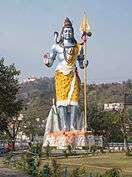  .jpg) Aarti at Har-ki-Pauri Chandidevi Temple, Har-ki-Pauri in morning Mansadevi, Railway Station Shiv Murti near Ganga, Evening view of Har-ki-Pauri Ropeway to Chandi Devi Temple | |
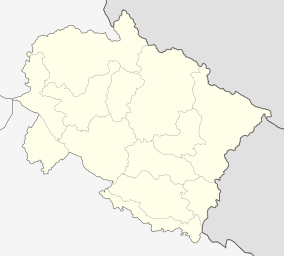 Haridwar  Haridwar | |
| Coordinates: 29°56′42″N 78°09′47″E / 29.945°N 78.163°ECoordinates: 29°56′42″N 78°09′47″E / 29.945°N 78.163°E | |
| Country |
|
| iState | Uttarakhand |
| District | Haridwar district |
| Area | |
| • City | 12.3 km2 (4.7 sq mi) |
| Elevation | 314 m (1,030 ft) |
| Population (2011)[1] | 228,832[2] |
| • Metro | 231,338 |
| Languages | |
| • Official | Hindi |
| Time zone | UTC+5:30 (IST) |
| PIN | 249401 |
| Telephone code | 01334 |
| Vehicle registration | UK-08 |
| Sex ratio | 1.18[1] ♂/♀ |
| Website |
uk |
Haridwar (pronounced [hʌrɪˌdwɑ:]) ![]()
Haridwar or Hardwar is regarded as one of the seven holiest places (Sapta Puri) to Hindus. According to the Samudra manthan,[3] Haridwar along with Ujjain, Nashik and Prayag (Allahabad) is one of four sites where drops of Amrit, the elixir of immortality, accidentally spilled over from the pitcher while being carried by the celestial bird Garuda. This is manifested in the Kumbha Mela, which is celebrated every 12 years in Haridwar. During the Haridwar Kumbh Mela, millions of pilgrims, devotees, and tourists congregate in Haridwar to perform ritualistic bathing on the banks of the river Ganges to wash away their sins to attain Moksha. Brahma Kund, the spot where the Amrit fell, is located at Har ki Pauri (literally, "footsteps of the Lord") and is considered to be the most sacred ghat of Haridwar.[4] It is also the primary center of the Kanwar pilgrimage, in which millions of participants gather sacred water from the Ganga and carry it across hundreds of miles to dispense as offerings in Śiva shrines.[5]
Haridwar is the headquarters and the largest city of the district. Today, the city is developing beyond its religious importance, with the fast developing industrial estate of State Industrial Development Corporation of Uttarakhand (SIDCUL), and the close by township of Bharat Heavy Electricals Limited as well as its affiliated ancillaries.
Haridwar presents a kaleidoscope of Indian culture and development. In the sacred writings it has been differently specified as Kapilsthan, Gangadwar and Mayapuri. It is additionally a passage indicate the Char Dham (the four principle focuses of journey in Uttarakhand viz, Badrinath, Kedarnath, Gangotri, and Yamunotri), subsequently, Shaivaites (adherents of Lord Shiva) and Vaishnavites (devotees of Lord Vishnu) call this place Hardwar and Haridwar individually, relating to Har being Shiv and Hari being Vishnu.
Etymology

The name of the town has two spellings: Hardwar and Haridwar. Each of these names has its own connotation.
Hari means "Lord Vishnu". So, Haridwar stands for " The Gateway to Lord Vishnu". In order to reach Badrinath, one of the four Char Dhams, with a temple of Lord Vishnu, Haridwar is a typical place to start a pilgrim's journey. Therefore, the name Haridwar.
On the other hand, in Sanskrit, Hara means "Lord Shiva" and Dwara means "gate" or "gateway".[3] Hence, Hardwar stands for "Gateway to Lord Shiva". Hardwar has been a typical place to start a pilgrim's journey in order to reach Mount Kailash, the eternal abode of Lord Shiva, Kedarnath, the northernmost Jyotirlinga and one of the sites of the smaller Char Dham pilgrimage circuit and Gaumukh, the source of River Ganga. Har ki Pauri or footsteps of Lord Shiva is considered the most sacred site in Hardwar.
Haridwar is also known as the home of Devi Sati and the palace of her father Daksha. In ancient times, the town was also referred to as Gangadwára (गंगाद्वार), the place where the Ganges descends to the plains.[6]
| Wikisource has original text related to this article: |
In the annotations to her poem 'Hurdwar. A Place of Hindoo Pilgrimage', Letitia Elizabeth Landon provides information on this name derivation, and also the story of the supposed origin of the 'River Ganges'.
Seven Holy Places
"Ayodhyā Mathurā Māyā Kāśī Kāñcī Avantikā
Purī Dvārāvatī caiva saptaitā mokṣadāyikāḥ"– Garuḍa Purāṇa I XVI .14
Lit. Ayodhya, Mathura, Haridwar, Kasi, Kanchi, Avantika and Dwaraka are the seven holy places.[7]
Note the use of puranic name 'Maya' for Haridwar. As also the inter-change usage of Puri and Dwaraka.
The Garuḍa Purāṇa enumerates seven cities as giver of Moksha. Haridwar is said to be one of the seven most holy Hindu places (=Kṣetra) in India, with Varanasi usually considered the holiest. A Kṣetra is a sacred ground, a field of active power, a place where Moksha, final release can be obtained.
History
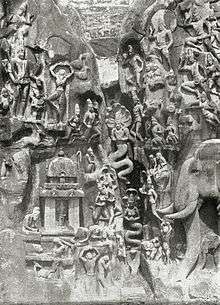
In the scriptures, Haridwar has been variously mentioned as Kapilasthana, Gangadwara[8] and Mayapuri. It is also an entry point to the Char Dham (the four main centres of pilgrimage in Uttarakhand viz, Badrinath, Kedarnath, Gangotri, and Yamunotri), hence, Shaivaites (followers of Lord Shiva) and Vaishnavites (followers of Lord Vishnu) call this place Hardwar and Haridwar respectively, corresponding to Hara being Shiv and Hari being Vishnu.[8][9][10]
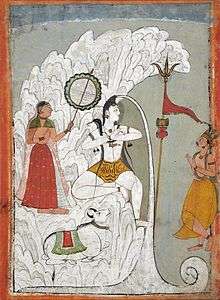
The Mahabharata, Vana Parva: Tirthayatra Parva: Section XC.[11]
In the Vanaparva of the Mahabharat, where sage Dhaumya tells Yudhishthira about the tirthas of India, Gangadwar, i.e., Haridwar and Kankhal, have been referred to,[12] the text also mentions that Agastya Rishi did penance here, with the help of his wife, Lopamudra (the princess of Vidharba).[13]
Sage Kapila is said to have an ashram here giving it, its ancient name, Kapila or Kapilasthana.[14]
The legendary King, Bhagiratha, the great-grandson of the Suryavanshi King Sagar (an ancestor of Rama),[15] is said to have brought the river Ganges down from heaven, through years of penance in Satya Yuga, for the salvation of 60,000 of his ancestors from the curse of the saint Kapila, a tradition continued by thousands of devout Hindus, who brings the ashes of their departed family members, in hope of their salvation.[16] Lord Vishnu is said to have left his footprint on the stone that is set in the upper wall of Har Ki Pauri, where the Holy Ganges touches it at all times.
Haridwar came under the rule of the Maurya Empire (322–185 BCE), and later under the Kushan Empire (c. 1st–3rd centuries). Archaeological findings have proved that terra cotta culture dating between 1700 BCE and 1200 BCE existed in this region.[10] First modern era written evidence of Haridwar is found in the accounts of a Chinese traveller, Huan Tsang, who visited India in 629 AD.[17] during the reign of King Harshavardhan (590–647) records Haridwar as 'Mo-yu-lo', the remains of which still exist at Mayapur, a little to the south of the modern town. Among the ruins are a fort and three temples, decorated with broken stone sculptures,[9][18][19] he also mentions the presence of a temple, north of Mo-yu-lo called 'Gangadwara', Gateway of the Ganges.[9]
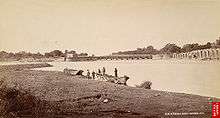
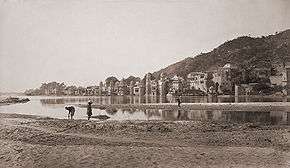
The city also fell to the Central Asian conqueror Timur Lang (1336–1405) on 13 January 1399.[20]
During his visit to Haridwar, first Sikh Guru, Guru Nanak (1469–1539) bathed at 'Kushawart Ghat', wherein the famous, 'watering the crops' episode took place,[21][22] his visit is today commemorated by a gurudwara (Gurudwara Nanakwara), according to two Sikh Janamsakhis, this visit took place on the Baisakhi day in 1504 AD, he later also visited Kankhal en route to Kotdwara in Garhwal.[23] Pandas of the Haridwar have been known to keep genealogy records of most of the Hindu population. Known as vahis, these records are updated on each visit to the city, and are a repository of vast family trees of family in North India.[23]
Ain-e-Akbari, written by Abul Fazal in the 16th century during the reign of Mughal Emperor Akbar, refers to it as Maya (Mayapur), known as Hardwar on the Ganges", as seven sacred cities of Hindus. It further mentions it is eighteen kos (each approx. 2 km) in length, and large numbers of pilgrims assemble on the 10th of Chaitra.[24] It also mentions that during his travels and also while at home, Mughal Emperor, Akbar drank water from the Ganges river, which he called 'the water of immortality'. Special people were stationed at Sorun and later Haridwar to dispatch water, in sealed jars, to wherever he was stationed[25]
During the Mughal period, there was mint for Akbar's copper coinage at Haridwar. It is said that Raja Man Singh of Amber, laid that foundation of the present day city of Haridwar and also renovated the ghats at Har Ki Pauri. After his death, his ashes are also said to have been immersed at Brahma Kund. Thomas Coryat, an English traveller, who visited the city in the reign of Emperor Jahangir (1596–1627) mentions it as 'Haridwara', the capital of Shiva.[9]
Being one of the oldest living cities, Haridwar finds its mention in the ancient Hindu scriptures as it weaves through the life and time stretching from the period of the Buddha, to the more recent British advent. Haridwar has a rich and ancient religious and cultural heritage. It still has many old havelis and mansions bearing exquisite murals and intricate stonework.
One of the two major dams on the river Ganges, the Bhimgoda, is situated here. Built in the 1840s, it diverts the waters of the Ganges to the Upper Ganges Canal, which irrigated the surrounding lands. Though this caused severe deterioration to the Ganges water flow, and is a major cause for the decay of the Ganges as an inland waterway, which till the 18th century was used heavily by the ships of the East India Company, and a town as high up as Tehri, was considered a port city The headworks of the Ganges Canal system are located in Haridwar. The Upper Ganges Canal was opened in 1854 after the work began in April 1842,[26] prompted by the famine of 1837–38. The unique feature of the canal is the half-kilometre-long aqueduct over Solani river at Roorkee, which raises the canal 25 metres above the original river.
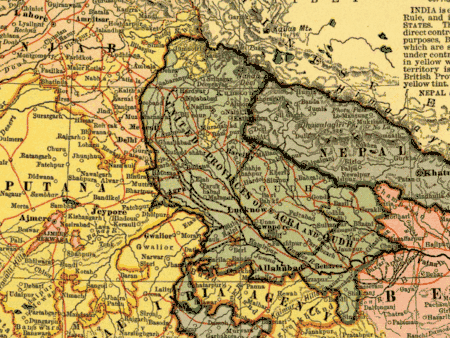
'Haridwar Union Municipality' was constituted in 1868, which included the then villages of Mayapur and Kankhal. Haridwar was first connected with railways, via Laksar, through branch line in 1886, when the Awadh and Rohilakhand Railway line was extended through Roorkee to Saharanpur, this was later extended to Dehradun in 1900.[27]
In 1901, it had a population of 25,597 and was a part of the Roorkee tehsil, in Saharanpur district of the United Province,[9] and remained so till the creation of Uttar Pradesh in 1947.[28]
Haridwar has been an abode of the weary in body, mind and spirit. It has also been a centre of attraction for learning various arts, science, and culture. The city has a long-standing position as a great source of Ayurvedic medicines and herbal remedies and is home to the unique Gurukul (school of traditional education), including the Gurukul Kangri Vishwavidyalaya, which has a vast campus, and has been providing traditional education of its own kind, since 1902. Development of Haridwar took an upturn in the 1960s, with the setting up of a temple of modern civilisation, BHEL, a 'Maharatna PSU' in 1975, which brought along not just a its own township of BHEL, Ranipur, close to the existing Ranipur village, but also a set of ancillaries in the region. The University of Roorkee, now IIT Roorkee, is one of the oldest and most prestigious institutes of learning in the fields of science and engineering.
Geography and climate
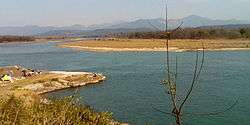
The Ganges emerges from the mountains to touch the plains. The water in the river Ganges is mostly clear and generally cold, except in the rainy season, during which soil from the upper regions flows down into it.
The river Ganges flows in a series of channels separated from each other called aits, most of which are well wooded. Other minor seasonal streams are Ranipur Rao, Pathri Rao, Ravi Rao, Harnaui Rao, Begham Nadi etc.[29] A large part of the district is forested, and Rajaji National Park is within the bounds of the district, making it an ideal destination for wildlife and adventure lovers. Rajaji is accessible through different gates; the Ramgarh Gate and Mohand Gate are within 25 km of Dehradun, while the Motichur, Ranipur and Chilla Gates are just about 9 km from Haridwar. Kunaon Gate is 6 km from Rishikesh, and Laldhang gate is 25 km from Kotdwara.
Haridwar district, covering an area of about 2360 km2, is in the southwestern part of Uttarakhand state of India.
Haridwar is situated at height of 314 metres from the sea level, between Shivalik Hills in the North and Northeast and the Ganges River in the South.[29]
Climate
Temperatures:
- Summers: 25 °C – 44 °C
- Winters: −1 °C – 24 °C[30]
| Climate data for Haridwar | |||||||||||||
|---|---|---|---|---|---|---|---|---|---|---|---|---|---|
| Month | Jan | Feb | Mar | Apr | May | Jun | Jul | Aug | Sep | Oct | Nov | Dec | Year |
| Average high °C (°F) | 20 (68) |
22 (72) |
27 (81) |
33 (91) |
36 (97) |
34 (93) |
31 (88) |
30 (86) |
30 (86) |
29 (84) |
26 (79) |
22 (72) |
28 (83) |
| Average low °C (°F) | 7 (45) |
9 (48) |
13 (55) |
18 (64) |
21 (70) |
23 (73) |
23 (73) |
23 (73) |
21 (70) |
17 (63) |
11 (52) |
8 (46) |
16 (61) |
| Average precipitation mm (inches) | 72 (2.83) |
76 (2.99) |
78 (3.07) |
55 (2.17) |
113 (4.45) |
296 (11.65) |
599 (23.58) |
568 (22.36) |
301 (11.85) |
102 (4.02) |
23 (0.91) |
91 (3.58) |
2,374 (93.46) |
| Source: Sunmap | |||||||||||||
Cityscape


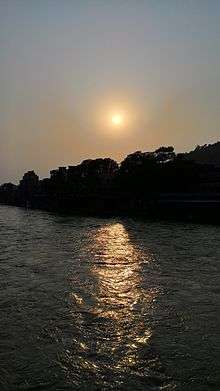
Hindu genealogy registers at Haridwar
%2C_1880s.jpg)
Something that is not well known today to Indians and to those settled abroad, in an ancient custom detailed family genealogies of Hindu families for the past several generations are kept by professional Hindu Brahmins popularly known as Pandas, at the Hindu holy city of Haridwar in hand written registers passed down to them over generations by their Brahmin ancestors which are classified according to original districts and villages of one's ancestors, with special designated Brahmin families being in charge of designated district registers, even for cases where ancestral districts and villages that have been left behind in Pakistan after Partition of India with Hindus having to migrate to India. In several cases present day descendants are now Sikhs and many maybe Muslims or even Christians. It is common for one to find details of up to, or even more than, ones seven past generations in these genealogy registers kept by the Pandas of Haridwar.
For centuries when Hindu ancestors visited the holy town of Haridwar for any purpose which may have mostly been for pilgrimage purposes or/and for cremation of their dead or for immersion of ashes and bones of their kin after cremation into the waters of the holy river Ganges as required by Hindu religious custom, it has been an ancient custom to go to the Pandit who is in charge of one's family register and update the family's genealogical family tree with details of all marriages, births and deaths from ones extended joint family.
In present-day India people visiting Haridwar are dumbfounded when Pandas out of the blue solicit them to come and update their very own ancestral genealogical family tree. News travels like wildfire among the Pandas with ones family's designated Panda being quickly notified of ones visit. Nowadays with Hindu joint family system having broken down with people preferring more nuclear families, record keeping Pandits prefer visitors to Haridwar to come prepared after getting in touch with all of ones extended family and bringing all relevant details regarding ones ancestral district and village, names of grand parents and great grand parents and marriages, births and deaths that have occurred in the extended family, even with as much details as possible of the families married into. A visiting family member is required to personally sign the family genealogical register furnished by ones Family Panda after updating it for future family visitors and generations to see and to authenticate the updated entries. Friends and other family members accompanying on the visit may also be requested to sign as witnesses. However it is preferable to visit one's family pandas before immerson of ashes of one's kin as they will help properly in this rituals.
Demographics
As of 2001 India census,[32] Haridwar district now has population of 1,890,422 (2011) and before had 1,447,187 (2001)
Haridwar city has 310,562 population (2011). Males constitute 54% of the population and females, 46%. Haridwar has an average literacy rate of 70%, higher than the national average of 59.5%: male literacy is 75%, and female literacy is 64%. In Haridwar, 12% of the population is under six years of age.
Places of interest
| “ | "Haridvāre Kuśāvarte Bilvake Nīla parvate
snatvā Kanakhale tīrth punarjanma na vidyate" |
” |
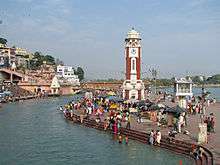
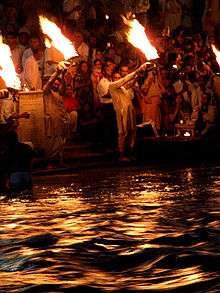
In Hindu traditions, the 'Panch Tirth' (Five Pilgrimages) within Haridwar, are "Gangadwar" (Har ki Pauri), Kushawart (Ghat in Kankhal), Bilwa Tirtha (Mansa Devi Temple) and Neel Parvat (Chandi Devi Temple). There are several other temples and ashrams located in and around the city. Also, alcohol and non-vegetarian food is not permitted in Haridwar.
Har Ki Pauri
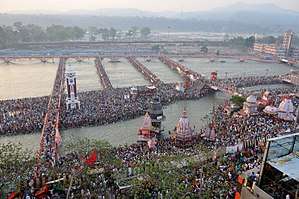
This sacred Ghat was constructed by King Vikramaditya (1st century BC) in memory of his brother Bharthari. It is believed that Bharthari came to Haridwar and meditated on the banks of the holy Ganges. When he died, his brother constructed a Ghat in his name, which later came to be known as Har Ki Pauri. The most sacred ghat within Har Ki Pauri is Brahmakund. The evening prayer (Aarti) at dusk offered to Goddess Ganga at Har Ki Pauri (steps of God Hara or Shiva) is an enchanting experience for any visitor. A spectacle of sound and colour is seen when, after the ceremony, pilgrims float Diyas (floral floats with lamps) and incense on the river, commemorating their deceased ancestors. Thousands of people from all around the world do make a point to attend this prayer on their visit to Haridwar. A majority of present ghats were largely developed in the 1800s. On the night of Dussehra or a few days before that the Ganga Canal is dried in Haridwar to clean the riverbed. The water is restored on Dewali. It is believed that on Dussera Maa Ganga goes to her father's house and returns after Bhai Duj or Bhai Phota. It is for this reason that the waters in the Ganga canal in Haridwar are partially dried on the night of Dussehra and the waters are restored on the day of Bhai Duj or Bhai Phota.[33][34]
Chandi Devi Temple
The temple is dedicated to Goddess Chandi, who sits atop the 'Neel Parvat' on the eastern bank of the river Ganges. It was constructed in 1929 A.D. by the king of Kashmir, Suchat Singh. Skanda Purana mentions a legend, in which Chanda-Munda, the Army Chief of a local Demon Kings Shumbha and Nishumbha were killed by goddess Chandi here, after which the place got the name Chandi Devi. It is believed that the main statue was established by the Adi Shankaracharya in the 8th century A.D. The temple is a 3 km trek from Chandighat and can also be reached through a ropeway.
Mansa Devi Temple
Situated at the top of Bilwa Parwat, the temple of Goddess Mansa Devi, literally meaning the Goddess who fulfills desires (Mansa), is a popular tourist destination, especially because of the cable cars, which offer views of the city. The main temple houses two idols of the Goddess, one with three mouths and five arms, while the other one has eight arms.
Maya Devi Temple
Haridwar was previously known as Mayapuri which is because of the Goddess Maya Devi. Dating to the 11th century, this ancient temple of Maya Devi, the Adhishthatri Devi (Patron Goddess) of Haridwar, is considered one of the Siddhapithas and is said to be the place where the heart and navel of Goddess Sati had fallen. It is one of few ancient temples still standing in Haridwar, along with Narayani Shila temple and Bhairav Temple.
Kankhal
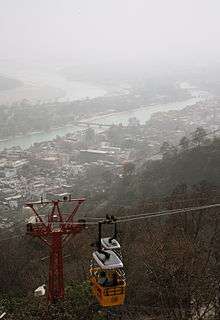

The ancient temple of Daksha Mahadev also known as Daksheshwar Mahadev Temple, is situated in the south Kankhal town. According to Hindu texts, King Daksha Prajapati, father of Dakshayani, Lord Shiva's first wife, performed a yagña, to which he deliberately did not invite Lord Shiva. When she arrived uninvited, he was further insulted by the king, seeing which Sati felt infuriated and self-immolated herself in the yagna kund. King Daksha was later killed by the demon Virabhadra, born out of Shiva's anger. Later the king was brought to life and given a goat's head by Shiva. Daksha Mahadev temple is a tribute to this legend.
Sati Kund, another well-known mythological heritage worth a visit is situated in the Kankhal. Legend has it that Sati immolated herself in this kund.
Piran Kaliyar
Piran Kaliyar Sharif, built by Ibrahim Lodhi, a ruler of Delhi, this 'Dargah' of Hazrat Alauddin Sabir Kaliyari, a 13th-century, Sufi Saint of Chishti Order (also known as Sarkar Sabir Pak), in Kaliyar village, 7 km. from Roorkee,[35] is visited by devotees from all over the world, during the annual 'Urs' festival, which is celebrated from 1st day of sighting the moon to 16th day of Rabi al-awwal month, in the Islamic calendar.
Neel Dhara Pakshi Vihar
This Bird Sanctuary is situated on the main Ganges river, or Neel Dhara, at the Bhimgoda Barrage, it is a paradise for bird watchers and home to many migratory birds during the winter season.
Bhimgoda Tank
This tank is situated at a distance of about 1 km from Har Ki Pauri. It is said that while Pandavas were going to Himalayas through Haridwar, prince Bhima drew water from the rocks here by thrusting his knee (goda), to the very ground.
Dudhadhari Barfani Temple
Part of the ashram of Dudhadhari Barfani Baba, this temple complex in white marble is an example of a temple in Haridwar, especially the temples of Rama-Sita and Hanumana.
Sureshvari Devi Temple

Temple of Goddess Sureshwari, situated in midst of Rajaji National Park. Serene and religious makes this temple abode of worshipers, saints etc. Located at outskirts of Haridwar in Ranipur and permission from forest rangers is necessary. The location of the temple is beyond the boundary of Bharat Heavy Electricals Limited, Haridwar.
Pawan Dham
A modern temple, made entirely of glass pieces, Pawan Dham is now a popular tourist destination. The temple complex was constructed by the effort of Swami Vedantanand Maharaj and the institute located there is growing under the leadership of Swami Sahaj Prakash Maharaj. People from Moga in Punjab have put considerable efforts and money to erect this place.
Bharat Mata Mandir
Bharat Mata Mandir is a multi-storey temple dedicated to Bharat Mata (Mother India). Bharat Mata Mandir was inaugurated on 15 May 1983 by Indira Gandhi on the banks of the river Ganges. It is situated adjacent to the Samanvaya Ashram, and stands eight stories tall to a height of 180 feet (55 m). Each floor depicts an era in the Indian history, from the days of Ramayana until India's independence.
On the first floor is the statue of Bharat Mata. The second floor, Shur Mandir, is dedicated to the well renowned heroes of India. The third floor Matri Mandir is dedicated to the achievements of India's revered women, such as Radha, Mira, Savitri, Draupadi, Ahilya, Anusuya, Maitri, Gargi etc. The great saints from various religions, including Jainism, Sikhism, and Buddhism are featured on the fourth floor Sant Mandir. The assembly hall with walls depicting symbolic coexistence of all religions practised in India and paintings portraying history in various provinces, is situated on the fifth floor. The various forms of the Goddess Shakti can be seen on the sixth floor, whilst the seventh floor is devoted to all incarnations of Lord Vishnu. The eighth floor holds the shrine of Lord Shiva from which devotees can gain a view of Himalayas, Haridwar, and the campus of Sapta Sarovar.
The temple was built under the former Shankaracharya Maha-Mandleshwar Swami Satyamitranand Giri Maharaj. Since the inception of the Swami Satyamitranand foundation in 1998, several other branches have been opened, namely in Renukut, Jabalpur, Jodhpur, Indore, and Ahmedabad.
Shopping
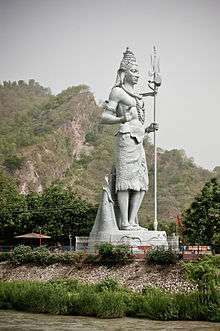
Famous places for shopping is Bara Bazar, Moti Bazar, Upper Road, Ranipur Mor, Jwalapur. Tourists usually buy items of devotion and inexpensive ornaments. There are large number of shops throughout Haridwar where one can buy devotional items ranging from Rudraksha ornaments, Religious pictures and deity statues to music cassettes of remixed devotional songs and bhajans. Garments are other major shopping attraction for locals.
Sapta Rishi Ashram and Sapta Sarovar
A place near Haridwar, where seven great sages or Saptarishis, namely Kashyapa, Vashishtha, Atri, Vishwamitra, Jamadagni, Bharadwaja and Gautama, said to have meditated. The Ganges split into seven currents at this place, so that the Rishis would not be disturbed by the flow.
Parad Shivling
Situated in Harihar Ashram, Kankhal. Parad Shivalinga (Mercury Shivalinga) weighing about 150 kg and Rudraksha tree are the main attractions here.
Ramanand Ashram
Situated in Shravan Nath Nagar of the town near railway station, this is the main ashram of Ramanand Sampraday in Haridwar. Mahant Bhagwan Das is the chief of this ashram.
Uma Maheswar Sanyas Ashram
It lies in the serene banks of Maa Ganga, in Bairagi Camp, far away from the hustle and bustle of the main city. It is part of Dakshinumrty Mutt, which holds the Acharya Mahamandaleswar post of Shree Niranjani Akhara. Current Head of this beautiful and spiritual Ashram is Niranjani Akhara Peethadheswar Ksotriya Bhramanist 1008 Shri Punyanand Giri ji Maharaj. It is also home to Sanskrit learning and Vedik learning for many students across the Globe.
Shri Chintamani Parshwnath Jain Shwetambar Mandir
.jpg)
This temple was built in 1990 by jain saint Shri Padam Sagar Suri. This temple is built by Jaisalmer stone in Jain architectural style. Moolnayak of this temple is a black colored idol of Chintamani Parshwnath Bhagwan in Padmasan posture. Idols of Shri Parshv Yaksh and Mata Padmawati on both sides of the main idol. There is alson an idol of Rishabhanatha made up of white marble. There is small temple of Shri Ghantakaran Mahavir Ji and charan-paduka's (foot imprints) near this temple. The temple also has a dharmshala for accommodation of around 1000 pilgrims at a time.[36][37][38]
Anandamayi Maa Ashram
Situated in Kankhal, one of five sub-cities of Haridwar, the ashram houses the samadhi shrine of Sri Anandamoyi Ma (1896–1982), a noted saint of India.
Shantikunj

Shantikunj is the headquarters of famous spiritual and social organisation All World Gayatri Pariwar (AWGP) established by Pandit Shriram Sharma Acharya. It is located at a distance of 6 kilometers from Haridwar railway station towards Rishikesh/Dehradun on NH58. At the bank of the holy Ganges and between the Shivalik ranges of the Himalayas, it is also a place of attraction for tourists as well as seekers of spiritual guidance.
Patanjali Yogpeeth (Trust)
Patanjali Yogpeeth is situated in Haridwar-Delhi Highway. This is a yoga institution and research center of Swami Ramdev. Every day thousands of people come here for yoga and other purposes.
Ramakrishna Math and Ramakrishna Mission Sevashrama
This is branch of the worldwide Ramakrishna Movement. The Mission centre was founded in 1901. The Math centre was started in 1980. The Math centre conducts daily worship and bhajans, and fortnightly Ramnam Sankirtan. Celebration of the birthdays of Sri Ramakrishna, Holy Mother Sri Sarada Devi, Swami Vivekananda and some other saints and prophets.
Educational institutions
Gurukul Kangri University
Situated in Kankhal, at the banks of the river Ganges, Gurukul Kangri University is one of the oldest Universities of India, it was founded in 1902 by Swami Shraddhananda (1856–1926), according to the tenets of Swami Dayananda Saraswati, the founder of Arya Samaj. It has also been visited by British Trade Union leader Charles Freer Andrews and British prime minister, Ramsay MacDonald, to study the unique Gurukul based education system. Here Ancient Vedic and Sanskrit literature, Ayurveda, Philosophy are part of the curriculum besides Modern Sciences and Journalism. Its 'Archaeological Museum', (established 1945) houses some rare statues, coins, paintings, manuscripts and artefacts, starting from Harappa culture (c. 2500–1500 BC). Mahatma Gandhi visited the campus three times, and stayed in its sprawling and serene campus for extended periods of time, most notably during the 1915 Kumbh mela,[39] followed by a visit in 1916, when on 20 March, he spoke at Gurukul Anniversary.[40]
Dev Sanskriti Vishwavidyalaya
Dev Sanskriti Vishwavidyalaya was established in 2002 by the act of the Uttarakhand Government is a fully residential university. Run by Shri Vedmata Gayatri Trust, Shantikunj, Haridwar (headquarters of All World Gayatri Pariwar), it provides various degree, diploma and certificate courses in areas like Yogic Science, Alternative Therapy, Indian Culture, Tourism, Rural Management, Theology, Spiritual Counseling etc. It also provides courses through distance learning.
Uttarakhand Sanskrit University
Set up by Government of Uttarakhand, the university is dedicated to studies of ancient Sanskrit scriptures and books. Also has curriculum covering ancient Hindu rituals, culture and tradition, and boasts of a building inspired by ancient Hindu architecture style.
Chinmaya Degree College
Situated in Shivalik Nagar, 10 km from Haridwar city. one of the science colleges in Haridwar.
HEC PG College
It was established in the year 2002. HEC College provides Undergraduate, Postgraduate, PG diploma courses. The courses are in the field of commerce, Management, Science, Lib. Science and Arts and it is affiliated to HNB Garhwal University, Sri Nagar, Garhwal, and Sri Dev Suman Uttarakhand University, Badshahithol, Tehri Garhwal.
Other colleges
There are two State Ayurvedic College & Hospital in Haridwar, one is Rishikul State Ayurvedic College (has PG level courses) and other is Gurukul Ayurvedic College.
Other schools
- Jawahar Navodaya Vidyalaya (Roshnabad, Haridwar)
- Campion School ICSE
- Angels' Academy Senior Secondary School- Baharabad
- Vidya Mandir Senior Secondary School Sector - 1 BHEL
- Vidya Mandir Senior Secondary School Sector - 5 BHEL
- Bal Bharti Senior Secondary School Sector - 4 BHEL
- Gyan Deep School Sector - 4 BHEL
- Bal Bhawan Sector - 1 BHEL
- St. Mary's Senior Secondary School
- Bhagirathi Vidyalaya Senior Secondary CBSE School, Haripurkalan
- Delhi Public School, Haridwar
- D.A.V. Centenary Public School
- Kendriya Vidyalaya, B.H.E.L. Haridwar
- Pannalal Bhalla Municipal Inter College
- Arya Inter College
- Holy Ganges Public School
- School of Computer Education, B.H.E.L. Haridwar
- Shivedale School
- Gayatri Vidyapeeth
- Whizzkid International School.
- Bal Mandir Senior Secondary School Sector - 1 BHEL
- The Wisdom Global School, Jwalapur
- Sheel Institute, Shivalik Nagar
- Swami Hariharanand Public School, Kankhal
Important areas within the city
B.H.E.L., Ranipur Township The campus of Bharat Heavy Electricals Limited, a Maharatna Public Sector Undertaking (PSU) is spread across an area of 12 km2. The main factory consists of two divisions: the Heavy Electricals Equipment Plant (HEEP), and the Central Foundry Forge Plant (CFFP). Together they employ over 8000 skilled employees. The campus is divided into six sectors providing excellent residential, schooling and medical facilities.
Bahadrabad – 7 km. It is located on the Haridwar–Delhi National Highway at a distance of 7 km from Haridwar. Close by, in village Pathri, lies the Bhimgoda Barrage built on the Upper Ganges Canal in 1955. It also has a block development office responsible for many developed villages (e.g. Khedli, Kisanpur Rohalki, Atmalpur Bongla, Sitapur, Alipur, Salempur).
SIDCUL – 5 km. A massive industrial area, spread over 2034 acres, developed by State Industrial Development Corporation of Uttarakhand (SIDCUL), a state government body. With the arrival of big enterprises like ITC, Hindustan Unilever Limited, Dabur, Mahindra & Mahindra, Havells and Kirby, SIDCUL is set to develop into another industrial township within the city. 3 km away from the Delhi-Hardwar National Highway, SIDCUL lies adjacent to the BHEL Township, an important Public Sector township.
Jwalapur An old part of the city, Jwalapur is the financial and industrial capital of the city, and now an important trading and shopping centre for the locals. The town dates back to 1700 AD. This town was called Mohammed pura and ruled by a local Muslim ruler. In the early 1600s the family of Sisodias from Mewar, descendants of Rana Pratap, fleeing from the Mughal invasion, came to settle on the outskirts of Haridwar. The families lived quietly for almost a generation to avoid detection. Local people renamed their surname to Mehta. It is firmly believed that in early 1700 the Mehtas dislodged the Muslim ruler and renamed the town as Jwalapur. This family subsequently settled in Jwalapur itself and intermarried with the local population.
Cheela Dam A good picnic spot with a dam and a man-made lake nearby. Elephants and other wild animals may be spotted.
Shivalik Nagar One of the newest and biggest residential areas of Haridwar. It is divided into various clusters. It was originally developed as a residential colony for BHEL employees, but with the advent of SIDCUL, population and financial activity has grown rapidly in the area due to its proximity.
Transport

Haridwar is headquarters of Haridwar district and it has good connectivity with the other towns of the district and the state.
Road
National Highway 58, between Delhi and Mana Pass passes through Haridwar connecting it with Ghaziabad, Meerut, Muzzafarnagar, Roorkee and Badrinath and National Highway 74 originating from Haridwar connects it with Kashipur, Kichha, Nagina, Pilibhit and Bareilly. Haridwar is well connected to all major cities by bus. Buses from Delhi to Haridwar are available daily, more than 150 buses are available.
Rail
The Haridwar Railway Station located in Haridwar is under the control of the Northern Railway zone of the Indian Railways. It has direct links the major cities of India such as Kolkata, Delhi, Mumbai, Jaipur, Jodhpur, Ahmedabad, Patna, Gaya, Varanasi, Allahabad, Bareilly, Lucknow, Puri, and major cities of Central India namely Bhopal, and Indore, khandwa, Itarsi.
Air
The nearest domestic airport is Jolly Grant Airport in Dehradun which is a located 35 km from Haridwar. Indira Gandhi International Airport in New Delhi is the nearest International Airport.
Industry
Haridwar is rapidly developing as an important industrial township of Uttarakhand since the state government agency, SIDCUL established in 2002, set up the Integrated Industrial Estate in a district attracting many important industrial houses which are setting up manufacturing facilities in the area.
Haridwar has a thriving industrial area situated at the bypass road, comprising mainly ancillary units to PSU, BHEL, which was established here in 1964 and currently employs over 8000 people.
Notable people
See also
References
- 1 2 "haridwar City Polulation Census of India, 2011". Office of the Registrar General, India. 2 March 2002. Retrieved 23 August 2015.
- ↑ Hardwar Population Census 2011
- 1 2 About Haridwar sahajaharidwar.
- ↑ Gopal, Madan (1990). K.S. Gautam, ed. India through the ages. Publication Division, Ministry of Information and Broadcasting, Government of India. p. 178.
- ↑ Singh, Vikash (2017). Uprising of the Fools. Stanford University Press. ISBN 9781503601673.
- ↑ Gangadwára, the place where the Ganges descends to the plains ... Sacrifice to Daksha (From the Vayu Purana.) The Vishnu Purana, translated by Horace Hayman Wilson, 1840. p. 62, 62:2.
- ↑ Kramrisch, Stella (25 February 2018). "The Hindu Temple". Motilal Banarsidass Publ. – via Google Books.
- 1 2 Places of peace and power sacred sites.
- 1 2 3 4 5 Roorkee Town The Imperial Gazetteer of India, v. 21, p. 324.
- 1 2 Haridwar History Archived 10 December 2007 at the Wayback Machine. Haridwar Official website.
- ↑ Yudhishthira The Mahabharata, translated by Kisari Mohan Ganguli (1883 -1896), Book 3: Vana Parva: Tirthayatra Parva: Section XC, p 204.
- ↑ Historical, Cultural and Social Perspectives Chapter 3, The Cultural Dimension of Ecology, Baidyanath Saraswati, 1998, Indira Gandhi National Centre for the Arts. ISBN 81-246-0102-X. ignca.nic.in. Vanaparva (The Book of the Forest) is third parva, book of Mahabharata.
- ↑ Lopamudra The Mahabharata, translated by Kisari Mohan Ganguli (1883 -1896), Book 3: Vana Parva: Tirthayatra Parva: Section XCVII.
- ↑ Stevenson, William; Burn, Richard; Sutherland, James; Hope, Herbert. The Imperial Gazetteer of India V2. Oxford, Clarendon Press. p. 52. Retrieved 4 May 2017.
- ↑ "The Descent of the Ganges". www.indiantemples.com.
- ↑ "Haridwar Travel Agent,Haridwar Rishikesh Tour,Haridwar Yatra". www.hardwar.com.
- ↑ Kumbh Mela Channel 4.
- ↑ Digital Library The Imperial Gazetteer of India, Oxford, 1908, Vol.13, p.51.
- ↑

- ↑ History The Imperial Gazetteer of India, v. 2, p. 570.
- ↑ Munde, Amarpreet Singh. "Guru Nanak (for Children) - A New Way of Teaching". www.gurmat.info.
- ↑ Life Of Guru Nanak: Chapter IV The Sikh Religion, Volume 1, by Max Arthur Macauliffe (1842–1913), Oxford University Press (1909). page 50-52.
- 1 2 Janasakhi Janamsakhis of Miharban and Mani Singh, Janamsakhi Tradition, Dr. Kirpal Singh, 2004, Punjabi University, Patiala. ISBN 81-7205-311-8. www.globalsikhstudies.net.
- ↑ Sacred Places of Pilgrimage Ain-e-Akbari, Vol. III, p. 306.
- ↑ Hardwar Ain-e-Akbari, by Abul Fazl 'Allami, Volume I, A´I´N 22. The A´bda´r Kha´nah. P 55. Translated from the original Persian, by Heinrich Blochmann and Colonel Henry Sullivan Jarrett, Asiatic Society of Bengal. Calcutta, 1873–1907. "His Majesty calls this source of life "the water of immortality," and has committed the care of this department to proper persons.... Both at home and on travels, he drinks Ganges water."
- ↑ Upper Ganges Canal The Imperial Gazetteer of India, 1909, v. 12, p. 138.
- ↑ Trade and Communications The Imperial Gazetteer of India, v. 21, p. 375.
- ↑ History The Imperial Gazetteer of India, v. 13, p. 53.
- 1 2 City Development Plan: Haridwar Urban Development Department, Government of Uttarakhand. p.20.
- ↑ New District Archived 30 August 2008 at the Wayback Machine. Haridwar, www.gmvnl.com.
- ↑ Hardwar City Population Census 2011 - Uttarakhand
- ↑ "Census of India 2001: Data from the 2001 Census, including cities, villages and towns (Provisional)". Census Commission of India. Archived from the original on 2004-06-16. Retrieved 2008-11-01.
- ↑ "Haridwar". personal.carthage.edu.
- ↑ "The Tribune, Chandigarh, India - Dehradun Plus". www.tribuneindia.com.
- ↑ Piran Kaliyar Times of India, 13 March 2003.
- ↑ "Archived copy". Archived from the original on 27 August 2016. Retrieved 19 August 2016.
- ↑ haridwarrishikeshtourism.com. "Haridwar Temples, Haridwar Temple Tour, List of Temples in Haridwar". www.haridwarrishikeshtourism.com.
- ↑ "Shri Chintamani Parshwnath Jain Shwetambar Mandir, Haridwar, Uttarkhand". 18 January 2016.
- ↑ Kumbh Mela 1915 The Story of My Experiments with Truth/Part V/Lakshman Jhula.
- ↑ Chronology of Mahatma Gandhi's life/India 1916 Wiki Source.
Further reading
- Gateway to the Gods: Haridwar-Rishikesh. Rupinder Khullar, Reeta Khullar. 2004, UBS Publishers. ISBN 81-7476-460-7.
- Hardwar Mela From the Caves and Jungles of Hindostan (1879–80), by Helena Petrovna Blavatsky (1831–1891).
- Report, by Archaeological Survey of India, Alexander Cunningham. Published by Office of the Superintendent of Government Printing, 1871. Chapt 30: Haridwar or Gangadwara, p. 231–236.
- Chapter XVII: Himalayas, Hardwar. India, Past and Present, by Charles Harcourt Ainslie Forbes-Lindsay. Published by J.C. Winston, 1903. Page 295.
External links
| Wikimedia Commons has media related to Haridwar. |
| Wikisource has original text related to this article: |

- Official website of Haridwar district.